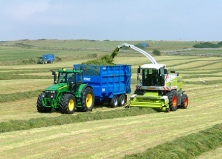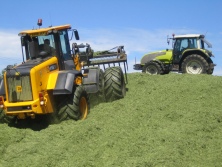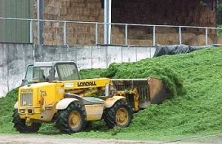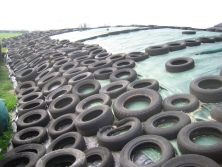Harvest Grass Silage at Optimum Digestibility for Dairy Cows
By 20th May the D-Value and protein level of most grass silage crops has already past it's best and is falling. This is made worse by the risk of crops going down. In the case of lodged crops we can expect a decline of 1.5 units per day as the bottom of the wet crop deteriorates.
Too often farmers wait for the weather and cut heavy, wet, low quality crops in June, still in poor weather conditions. The result in many cases can be a 30% increase in winter feed bills as very mature silages fail to perform. We know that a 20% dry matter, 11.5 ME silage cut early, will perform far better than a 9.5 ME, mature, high fibre, low digestibility, low protein silage cut later.
 There has been a trend in the UK in recent years for farmers to attempt to reduce contractors
bills by going for 2 cuts of silage instead of 4 or 5 cuts. First cut in early June and 2nd end of August or even into September depending on the weather. The logic is that 2 contractors bills must be cheaper than 3 or 4. Yet any dairy farmer knows that if you turn cows out of a nice lush aftermath into a field of grass that has been growing for
3 months, the milk will drop like a stone. This strategy has cost the UK dairy industry a fortune in lost milk and increased feed costs.
There has been a trend in the UK in recent years for farmers to attempt to reduce contractors
bills by going for 2 cuts of silage instead of 4 or 5 cuts. First cut in early June and 2nd end of August or even into September depending on the weather. The logic is that 2 contractors bills must be cheaper than 3 or 4. Yet any dairy farmer knows that if you turn cows out of a nice lush aftermath into a field of grass that has been growing for
3 months, the milk will drop like a stone. This strategy has cost the UK dairy industry a fortune in lost milk and increased feed costs.
The New Zealand rotational grazing enthusiasts have taught us that the optimum time between grazings to maximise grass growth and milk yield is 3 - 4 weeks. It seems logical for silaging to work on 5 - 6 weeks between cuts starting mid-May. That makes 4 cuts to take us into September. OK we might need one cut to be a bit more mature to add some scratch fibre to the diet, to promote cudding and form a rumen mat. We might get delayed by the weather and contractors at some point. So maybe 3 cuts, but aiming for 2 cuts only is quite clearly costing us a lot in terms of overall profitability.
Always use an Additive when making Grass Silage
Once the crop reaches optimum D-Value cut as soon as the ground is travelable. If the weather is right, do not be tempted to wait for the crop to bulk up. Use a good quality biological inoculant additive and go for it.
The silage additive used should ideally be a high specification freeze dried multi-strain bacterial inoculant. Do not be tempted to wait until the weather is perfect, the crop is deteriorating. Cutting at the first opportunity will reduce pressure on grazing next month and allows a bigger, better quality subsequent cuts. Check our Silage Making FAQ's page.
Pick the day, and mow mid-morning, after the crop has blown out. Leave a wide swath behind the mower and go for a rapid wilt. 2 hours after mowing, the stomata on the grass leaves close and wilting rates drop by 75%. If the weather is not conducive to wilting pick up the same afternoon after a short wilt. Once mown, if it rains continue picking up. Don't be tempted to leave the crop wilting for more than 24 hours.
 Once the crop is cut it is losing energy and deteriorating. Typically the crop will lose 5% each day that it is down. Get it in the pit without delay. Pay attention
to rolling and make sure that it is sealed thoroughly as soon as the clamp is filled.
If the seal is not 100% air tight, fermentation is delayed with increased dry
matter losses and spoilage which could have been avoided. In hot, dry weather, especially
with light crops 24 hours wilt is too long. Aim for 25% - 28% dry matter. It is almost
impossible on commercial farms to consolidate sufficiently or to get the air out of clamps
of mature grass at 30% - 50% dry matter.
Once the crop is cut it is losing energy and deteriorating. Typically the crop will lose 5% each day that it is down. Get it in the pit without delay. Pay attention
to rolling and make sure that it is sealed thoroughly as soon as the clamp is filled.
If the seal is not 100% air tight, fermentation is delayed with increased dry
matter losses and spoilage which could have been avoided. In hot, dry weather, especially
with light crops 24 hours wilt is too long. Aim for 25% - 28% dry matter. It is almost
impossible on commercial farms to consolidate sufficiently or to get the air out of clamps
of mature grass at 30% - 50% dry matter.
Always use an additive.
With cash flows tight, many farmers have resisted spending additional money on an additive, effectively ignoring all the research of the past 20 years
The case for using a modern biological additive is proven beyond all shadow of doubt. Irrespective of weather conditions an additive will give a milk yield response of around 1.5 litres of milk together with improvements in milk quality, body condition and fertility, as well as 4% - 5% more silage in the pit and a reduction in effluent. The result at current milk prices is at least a 6:1 return on investment.
The cost of not spending �1000 on a silage additive,
equates to up to £10000 lost profit
 For
silages below 25% dry matter we recommend using a well proven, high spec, multi-strain inoculant product
such as Ultra-Sile Rapid. It is
particularly important that the strains of bacteria used in the inoculant are capable of utilising the
full spectrum of grass sugars including fructans and exhibit a rapid fermentation throughout a wide range
of pH, temperature and forage dry matter conditions.
For
silages below 25% dry matter we recommend using a well proven, high spec, multi-strain inoculant product
such as Ultra-Sile Rapid. It is
particularly important that the strains of bacteria used in the inoculant are capable of utilising the
full spectrum of grass sugars including fructans and exhibit a rapid fermentation throughout a wide range
of pH, temperature and forage dry matter conditions.
Treating the silage with an advanced high specification inoculant will ensure that the fermentation losses are minimal and that the silage conserved is as close as possible in feed value to the original forage crop at the time of harvest.
Clamping Grass Silage
Good silage making practice requires attention to detail. Especially important are good hygiene, rapid filling, good consolidation, sheeting and face management. High quality inoculant treated silage has more feed value and is worth more than untreated silage. Pay attention to detail. Remember that the fermentation cannot begin until the air is out of the clamp. Good consolidation by effective rolling of no more than 6 inch layers of forage during the clamping process is essential if mould and yeast activity and poor stability is to be avoided. Avoid over filling silage clamps. Ramps and shoulders should never have greater than a 30o slope. Sheet as soon as the clamp is filled using a low transmission oxygen barrier film either Passion Yellow or Silostop protected with a good quality protective cover or woven silage net. Passion Yellow OB film is far more effective than using either black plastic or clear polythene film.
Dry Wilted Silages
UK grass clamp silages now average over 30% dry matter on both 1st and 2nd cuts. This has resulted
in increased problems with aerobic stability on the face and also in top and shoulder waste on many farms.
This is due to poorer consolidation of the lighter material, greater air penetration, lack of weight
on the top of pits, inadequate sealing of the clamp. THis has not been helped by the trend towards
cutting back on fertiliser and harvesting mature, stalky, lower energy crops which are difficult to consolidate
and which contain high levels of moulds and yeasts. A different approach is needed for dryer silages.
Additives for Dry Silages
When ensiling forages greater in dry matter than 25%, it is important to use a specialist high dry matter additive. Most commercial inoculants rely on lactic acid to preserve the forage. It is now well established that lactic acid is broken down easily by lactate assimilating yeasts, which feed off it as an energy source when silages start to heat. This make lactic only inoculants unsuitable for forages over 25% dry matter. There are a number of products available which contain chemical preservatives such as potassium sorbate, sodium benzoate and sulphites designed to control heating but these have their own problems. Consequently we now recommend the use of Ultra-Sile Dry, Ultra-Sile HiDri, Ultra-Sile Premium, Ultra-Sile Maize or Ultra-Sile Arable Silage Additives when clamping medium to high dry matter grass silage, big bales, maize and arable silages, fermented wholecrops and crimped cereals.
 Ultra-Sile
Dry and Ultra-Sile Arable are state of the art inoculants which are designed to give improved face
stability compared with lactic acid based products. These additives are well proven, more cost effective
than most other products available and have proved highly effective over a number of years. They have
the added advantage that they are equally effective in treating very wet forage down to 15% dry matter.
In order to maximise the profit potential of good silage always consolidate well, always make the clamp
air tight and always use an additive.
Ultra-Sile
Dry and Ultra-Sile Arable are state of the art inoculants which are designed to give improved face
stability compared with lactic acid based products. These additives are well proven, more cost effective
than most other products available and have proved highly effective over a number of years. They have
the added advantage that they are equally effective in treating very wet forage down to 15% dry matter.
In order to maximise the profit potential of good silage always consolidate well, always make the clamp
air tight and always use an additive.
Silage probably accounts for half of the diet of your dairy herd. Quality is important. Give silage making the attention it deserves.
Using an effective additive is always well worth the investment.
For more information or for an in depth consultation contact Richard Webster.
